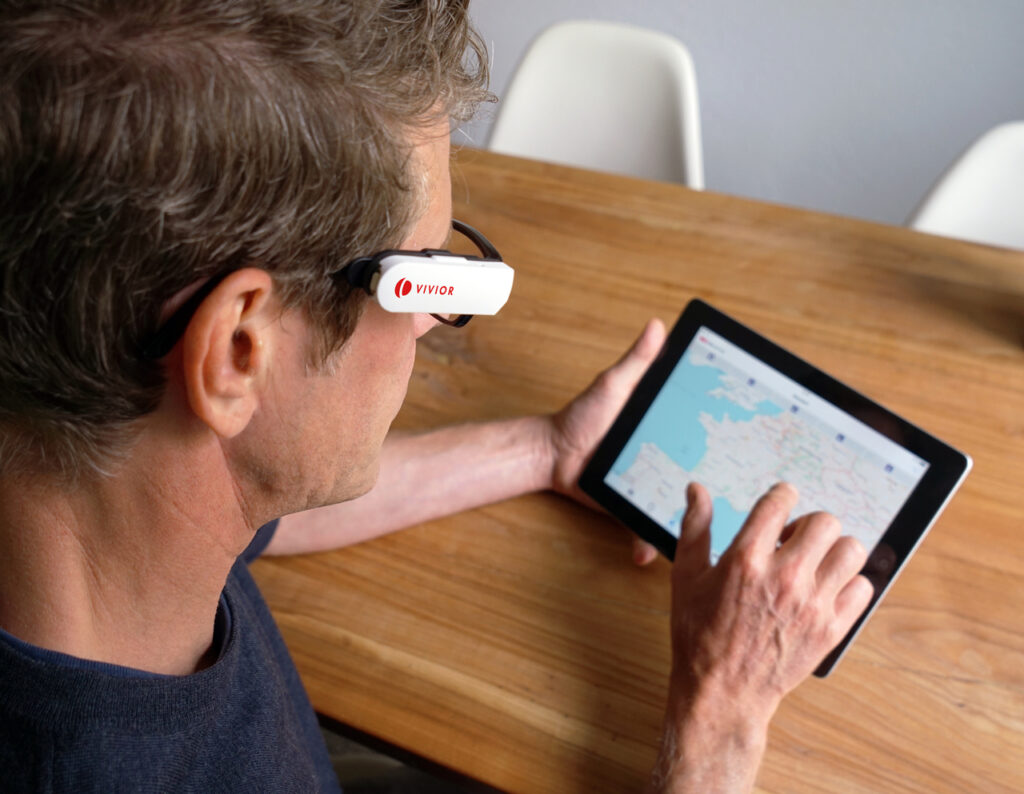
A new technology suggests the best option for refractive, cataract and presbyopia surgery
Placed on the patient’s glasses for 36 hours, this small device collects information on the activity and visual needs of patients with refractive errors or dysfunctional lens syndrome.
Our IMO Grupo Miranza centre is leading the way in Spain offering a new technology (Vivior Monitor), the aim of which is to help the ophthalmologist determine, with objective data, the best intraocular lens option for patients eligible for refractive surgery, as well as cataract or presbyopia. Up to now, data on a patient’s visual behaviour available to a surgeon were subjective in nature (mainly patient interviews and questionnaires) and did not allow their individual needs to be objectively taken into account. This new technology allows us to respond to personal needs according to the type of life and visual activity of each patient based on real data, hence optimising the results of surgeries.
Vivior Monitor collects data from everyday life
It is an extra-light device (14 g) with 5 built-in sensors that measure distances, lighting conditions (UV and blue) as well as head tilt and turn. The device is placed on the patient’s glasses prior to surgery and collects all this information about their daily visual activity for 36 hours. Thus, the ophthalmologist has access to data on how often distances are used by the patient, the time of use of each visual distance, as well as the lighting conditions, the objective measurement of the expected vision at different distances, etc.
The information provided by Vivior Monitor, which is stored in software, is used as a complement to a complete eye examination and other diagnostic tests of the person eligible for refractive, cataract or presbyopia surgery, which are essential to know all the details of the eye and to decide individually on the intraocular lens to be implanted.
This new technology is a major advance in improving the treatment of refractive errors and dysfunctional lens syndrome, which is caused by aging and causes the lens of the eye to lose its transparency and elasticity, hence affecting vision as time goes by.
What is dysfunctional lens syndrome?
From the age of 40 onwards, it is common for you to start to notice certain symptoms regarding your eyesight which, in most cases, are related to dysfunctional lens syndrome, the main cause of which is the natural aging process. “The crystalline lens is a natural lens behind the iris that allows us to focus on objects at different distances”, explains Dr José L. Güell, an ophthalmologist at IMO Grupo Miranza and a specialist in cornea and refractive surgery with more 30 years of experience in these visual alterations.
Over the years, “the crystalline lens ages, loses transparency, mobility, elasticity and becomes opaque. Light is unable to enter the eye correctly, and this changes your eyesight”, says the ophthalmologist. “If you think of the eye as a camera, the focus gradually slows down.”

The most common symptoms of dysfunctional lens syndrome are blurred vision, reduced sensitivity to colours and difficulty or changes in near vision. Symptoms evolve with age.
Cataracts and presbyopia or “eyestrain” are the two most common visual disorders linked to dysfunctional lens syndrome. In many cases, this syndrome can be effectively treated by prescribing glasses or performing refractive surgery to compensate for presbyopia in patients who do not wish to wear glasses. As far as cataracts are concerned, the solution is always surgical. Both in this case and in refractive surgery for presbyopia, the operation consists of removing the aged lens and replacing it with an intraocular lens that performs the same function.
“IMO Grupo Miranza has a wide range of intraocular lenses for presbyopia and cataract surgery (monofocal, multifocal, bifocal and trifocal). Thus, each patient can benefit from the one that best suits their visual needs, always on prescription and with medical advice”, concludes Güell.
Other technical advances for a comprehensive diagnosis
Early detection is key to health in general and eye health in particular. Patients usually start to notice changes in their eyesight, even before the ophthalmologist has detected a problem with the lens during a normal examination. To do this, IMO Grupo Miranza boasts HD Analyzer, a technical device capable of diagnosing dysfunctional lens syndrome at very early stages, hence making it possible to detect any opacity in the lens, which cannot be measured by other means. This instrument is also very useful for the early detection of dry eye.